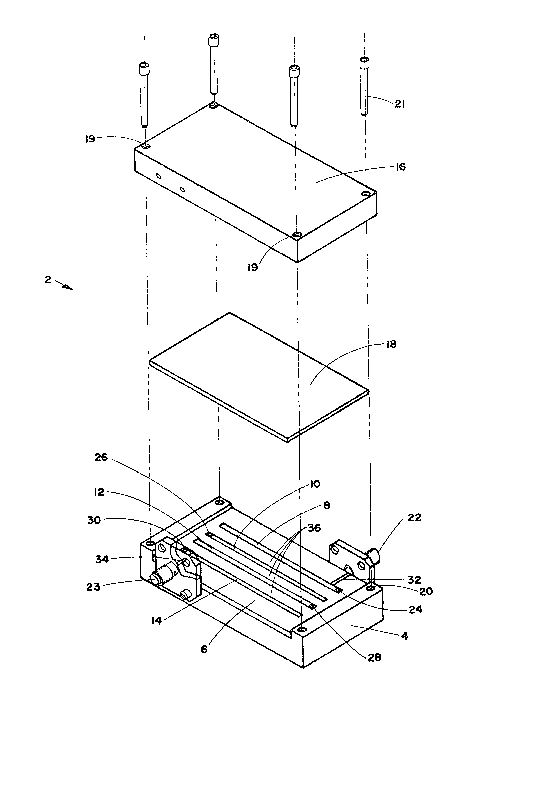Une partie des informations de ce site Web a été fournie par des sources externes. Le gouvernement du Canada n'assume aucune responsabilité concernant la précision, l'actualité ou la fiabilité des informations fournies par les sources externes. Les utilisateurs qui désirent employer cette information devraient consulter directement la source des informations. Le contenu fourni par les sources externes n'est pas assujetti aux exigences sur les langues officielles, la protection des renseignements personnels et l'accessibilité.
L'apparition de différences dans le texte et l'image des Revendications et de l'Abrégé dépend du moment auquel le document est publié. Les textes des Revendications et de l'Abrégé sont affichés :
| (12) Brevet: | (11) CA 1264073 |
|---|---|
| (21) Numéro de la demande: | 1264073 |
| (54) Titre français: | FILTRE PLANAR INTERNUMERIQUE A MICRORUBAN |
| (54) Titre anglais: | MICROSTRIPLINE INTERDIGITAL PLANAR FILTER |
| Statut: | Périmé et au-delà du délai pour l’annulation |
| (51) Classification internationale des brevets (CIB): |
|
|---|---|
| (72) Inventeurs : |
|
| (73) Titulaires : |
|
| (71) Demandeurs : |
|
| (74) Agent: | DARYL W. SCHNURRSCHNURR, DARYL W. |
| (74) Co-agent: | |
| (45) Délivré: | 1989-12-27 |
| (22) Date de dépôt: | 1989-02-09 |
| Licence disponible: | S.O. |
| Cédé au domaine public: | S.O. |
| (25) Langue des documents déposés: | Anglais |
| Traité de coopération en matière de brevets (PCT): | Non |
|---|
| (30) Données de priorité de la demande: | S.O. |
|---|
ABSTRACT
A microstripline interdigital planar filter
has a number of microstripline coupled resonators in
an inhomogeneous medium consisting a soft dielectric
substrate, and a high dielectric constant, high Q
ceramic superstrate. The resonators are printed on
the soft substrate as thick copper strips. The
rectangular shaped, silver-coated aluminum housing
dimensions are chosen so as to give the highest
available unloaded Q factor of the resonators. The
high dielectric constant of the superstrate is chosen
so as to give a very small resonator length resulting
in a very small filter size. The input and the output
ports are located at right tapping points on the two
outermost resonators. The tapping points are chosen
so as to match the loaded Q factor of the filter.
Previous filters are physically larger and cannot
achieve the same high level of performance
characteristics as filters of the present invention.
Note : Les revendications sont présentées dans la langue officielle dans laquelle elles ont été soumises.
Note : Les descriptions sont présentées dans la langue officielle dans laquelle elles ont été soumises.

2024-08-01 : Dans le cadre de la transition vers les Brevets de nouvelle génération (BNG), la base de données sur les brevets canadiens (BDBC) contient désormais un Historique d'événement plus détaillé, qui reproduit le Journal des événements de notre nouvelle solution interne.
Veuillez noter que les événements débutant par « Inactive : » se réfèrent à des événements qui ne sont plus utilisés dans notre nouvelle solution interne.
Pour une meilleure compréhension de l'état de la demande ou brevet qui figure sur cette page, la rubrique Mise en garde , et les descriptions de Brevet , Historique d'événement , Taxes périodiques et Historique des paiements devraient être consultées.
| Description | Date |
|---|---|
| Inactive : CIB de MCD | 2006-03-11 |
| Le délai pour l'annulation est expiré | 1999-12-29 |
| Lettre envoyée | 1998-12-29 |
| Accordé par délivrance | 1989-12-27 |
Il n'y a pas d'historique d'abandonnement
| Type de taxes | Anniversaire | Échéance | Date payée |
|---|---|---|---|
| TM (catégorie 1, 8e anniv.) - générale | 1997-12-29 | 1997-12-12 |
Les titulaires actuels et antérieures au dossier sont affichés en ordre alphabétique.
| Titulaires actuels au dossier |
|---|
| COM DEV LIMITED |
| Titulaires antérieures au dossier |
|---|
| PROTAP PRAMANICK |